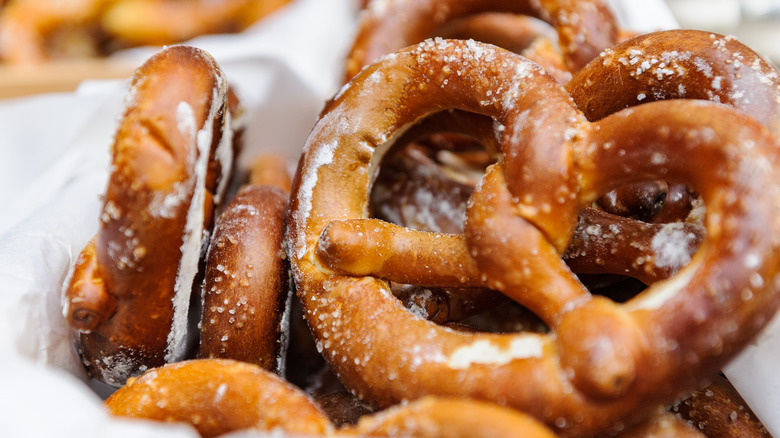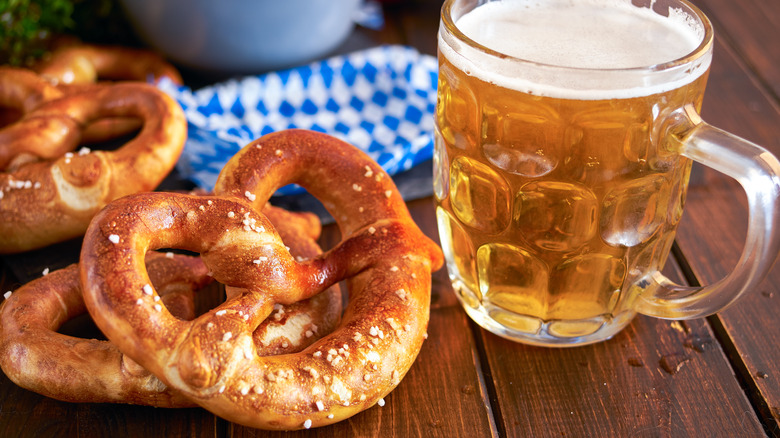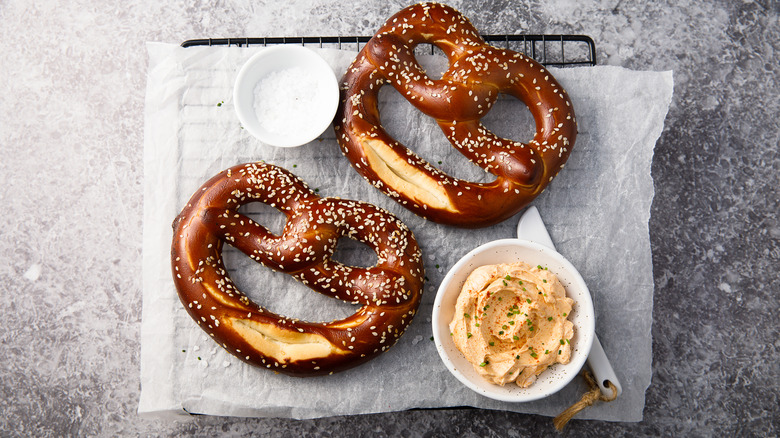Here's How Pretzels Came To America
Pretzels are an American delicacy. The average American eats about 1½ pounds of pretzels annually, according to National Today. A pretzel, at its simplest, is a twisty treat made from water and flour formed into a giant knot. Although, sometimes you'll find pretzel sticks and pretzel nuggets, too.
The doughy treat boasts several iterations; pretzels can be enjoyed salted or plain, topped with cinnamon sugar or garlic, glazed with vanilla or chocolate, and dunked in beer cheese, mustard, or yogurt. Whether you like soft or savory pretzels or hard and sweet pretzels, there are plenty of options to choose from.
Pretzels may be simple in their ingredients, but their classic twisted shape is rooted in several legends. According to History, the pretzel is credited for the introduction of the phrase "tying the knot." European royal couples reportedly used a pretzel at their weddings to "seal the bond of matrimony." Pretzels' knotted shapes have come to symbolize love. But that's not all.
Pretzel were first baked in Medieval Europe
As the Heinz History Center puts it, the history of the pretzel is pretty much as "tangled as its shape." It's believed that pretzels were invented in Medieval Europe by Italian monks who created the doughy snack as a reward for being well-behaved Catholic students. The famous pretzel shape was supposed to resemble praying arms. In fact, pretzels were called "bracellae," which is Latin for "little arms" and "pretiolas," meaning "little rewards," (via History).
During Lent, meat, dairy, and eggs were banned by the Catholic Church at the time. Pretzel was the go-to snack during Lent, per History. Pretzels' religious ties don't stop there. The snack was seen as a symbol of good luck and prosperity. It was given out to the poor, "as a way of providing them with both spiritual and literal sustenance." The three holes in the pretzel shape were supposed to represent the Father, Son, and Holy Spirit.
The knotted treat spread throughout Europe and is tied down to several lores. According to Food & Wine, monks helped defeat The Ottoman Empire from invading Austria in the 14th century. They were baking pretzels in the monastery's basement when they overheard the soldiers burrowing tunnels trying to enter the country.
Pretzels' presence in Pennsylvania
How did the pretzel become an American staple? Rumor has it that the pilgrims on the Mayflower brought over the treat (via History). However, that may not be true as it's also believed that German immigrants brought pretzels over to America — specifically Pennsylvania — around the 1700s.
The first American pretzel factory, Julius Sturgis Pretzel Bakery, was founded by Julius Sturgis in Pennsylvania in 1861, according to Philadelphia Magazine. The popular combo of pretzel and beer caught on during the late 19th century, per Heinz History Center. Pubs and breweries, which were majorly owned by German immigrants, realized pretzels were the "perfect bar food" due to their simplicity and cost. Pretzels were even sometimes referred to as "German biscuits."
Pretzels can be found anywhere today, so it's hard to imagine that they nearly vanished in existence. During World War I, anti-German sentiments led pretzels to be temporarily banned (via Philadelphia Magazine). Prohibition also almost threatened pretzels' existence.
Since Julius Sturgis Pretzel Bakery was founded in Pennsylvania, the state has garnered a reputation for being the pretzel capital of America. Inventions such as the pretzel stick and the automated pretzel maker were also created in the state (via Heinz History Center). About 80% of pretzels made in the U.S. today hail from Pennsylvania.


